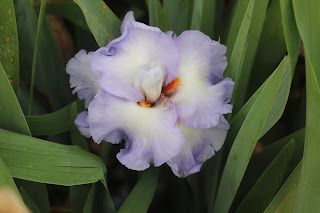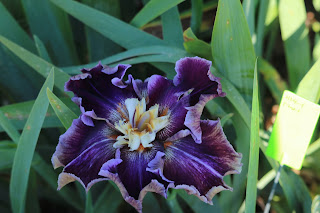by Tom Waters
Most of us are quite familiar with the gorgeous hybrid bearded irises grown in so many gardens around the world. Whether dwarf, median, or tall bearded, these irises are the great show-stoppers of the springtime iris parade. Every year, hybridizers introduce new varieties, so there is a never-ending stream of new colors, patterns, and flower forms.
But before hybridizers took an interest in irises - and that was scarcely more than 100 years ago - bearded irises in gardens were much like irises in nature. Yes, bearded irises are wildflowers in Europe and western Asia, where numerous different species grow on hillsides or in valleys without gardeners to care for them.
These wild bearded irises are of interest to some iris growers, for a variety of reasons. Some of us are just attracted to wild flowers, and like to see the plants as nature made them. Others are students of iris history, and it is these bearded species that are ancestral to our modern hybrids; growing them is like tracing the roots of our family tree. Others are hybridizers, curious to explore the untapped potential of these species.
Here is just a smattering of bearded iris species that may be of interest, with an emphasis on those that have been mentioned frequently in books and articles or that have featured prominently in the development of our modern bearded iris hybrids.
 |
| Iris pallida, a form with variegated foliage |
Iris pallida is a European tall bearded (TB) species, with light blue-violet flowers and straight stems with branching clustered near the top. To my eye, it is the most stately of all the bearded iris species.
I. variegata, another European species, is smaller, similar to miniature tall bearded (MTB) irises in size, with zig-zag stems and distinctively colored flowers with yellow standards and falls marked in wine-red or brick-red.
These two species are probably the sole ancestors of the diploid tall bearded irises grown in gardens in the 1800s and early 1900s. They hybridize in nature, and these natural hybrids (amoenas, bitones, and blends) were collected by flower lovers and grown in European gardens. Any modern TB iris that has yellow (or pink or orange) coloration owes its color to I. variegata.
 |
| Iris variegata |
The other wild irises important in the development of the modern TBs were a range of different tetraploid plants from various locations in the eastern Mediterranean. These include I. cypriana, I. trojana, I. mesopotamica, and some named clones such as 'Amas' and 'Ricardi'. All are purple bitones and large, well-branched plants. The botanical status of these is not as clear as might be, but every modern TB descends from them in some fashion. It was hybridizers of the early 20th century who crossed the colorful diploid pallida/variegata hybrids with these large tetraploids to create the modern tetraploid TBs that have become the most popular and widely grown of all irises.
 |
| Iris aphylla |
Moving down in height, we come next to I. aphylla, a species from eastern Europe that is usually similar to standard dwarf bearded (SDB) or intermediate bearded (IB) irises in height, but copiously branched, the lowest branch usually emerging right at ground level! The flowers are dark violet, and beards usually bluish. It has been used in two different ways in breeding modern bearded irises: first in breeding "black" TBs, and then later in the work of Ben Hager and others creating the tetraploid MTBs. See my earlier blog post Our Debt to Iris aphylla.
In the realm of dwarf species, the earliest known to western European gardeners was I. lutescens (once called I. chamaeiris), which is native to the warm Mediterranean areas of Spain, France, and Italy. It was the basis for our garden dwarf bearded irises until the 1950s. Its height varies, spanning the modern MDB and SDB classes and sometimes growing even a bit taller. Colors are yellows, violets, whites, and blended and bitoned versions of those colors. See my post Iris lutescens: The Dwarfs that Time Forgot.
 |
| Iris pumila seedlings |
The most important dwarf species in the development of modern dwarf and median irises is the species I. pumila, native to cooler, higher regions of eastern Europe. It is quite tiny, usually only about 4 inches tall, with blooms that appear almost stemless and spring straight from the rhizomes. It has an extensive color range, from white to blue, purple, rosy, and yellow, usually with a darker spot of violet, red, or brown. It came to the attention of iris breeders in western Europe and the US rather late, in the mid-20th century. Once "discovered," however, it became a power player in iris breeding. I. pumila, when crossed with TBs, produced the modern SDB class, and through them the modern MDBs and IBs as well. See Iris pumila: A Tiny Treasure.
Iris reichenbachii grows wild on the Balkan peninsula, where it exists in both diploid and tetraploid forms. The flowers are rather long in form, and most are either a dull yellow or a grayish violet. This species is notable in the history of iris breeding for introducing the "dominant amoena" gene into the TB gene pool through the work of Paul Cook. Most modern bicolors have I. reichenbachii back somewhere in their family tree. See The Untapped Potential of Iris reichenbachii.
 |
| Iris reichenbachii |
Also worthy of note is I. reichenachii's diploid relation, I. suaveolens (once called I. mellita). It is smaller than I. reichenbachii, but otherwise similar. It is noted for its sickle-shaped leaves, in some forms edged in a narrow line of red-violet pigment.
I hope this line-up of bearded species has piqued your interest. They are nice additions to the garden for anyone who is curious about where our garden iris "came from" or is attracted to the simple beauty of wildflower irises. One sometimes finds a few bearded species available from commercial iris growers, but more are consistently available through various seed exchanges from societies like the Species Iris Group of North America, the Scottish Rock Garden Club, the British Iris Society, or the Dwarf Iris Society.
Why not "go wild" and try some bearded species this year!










































